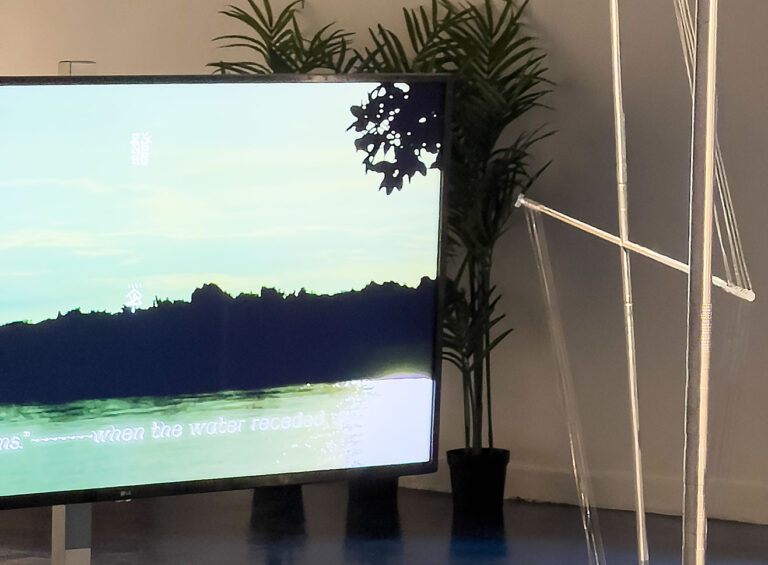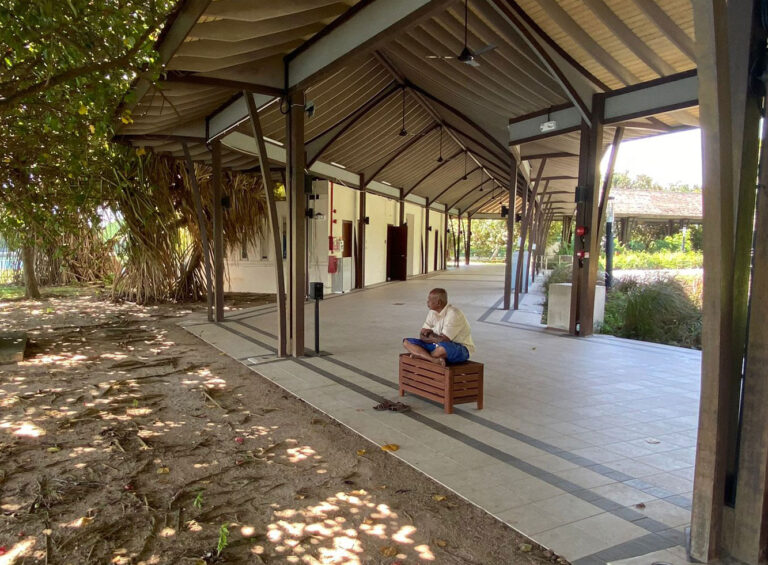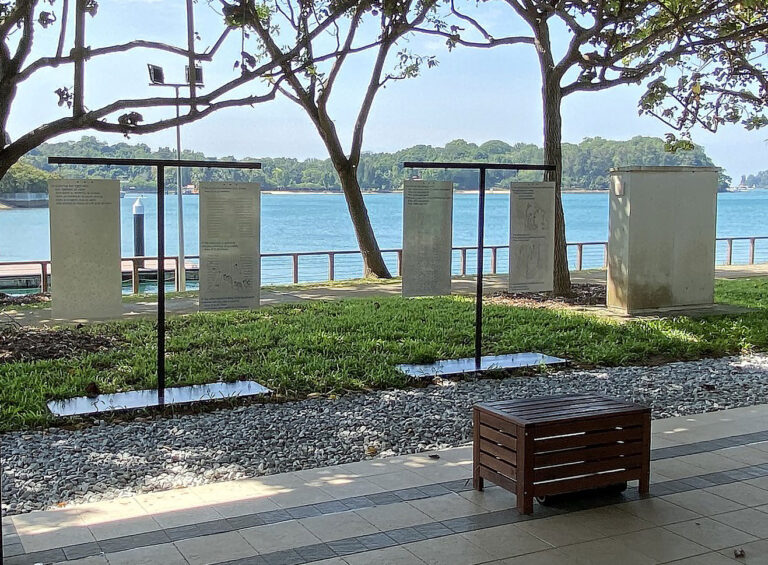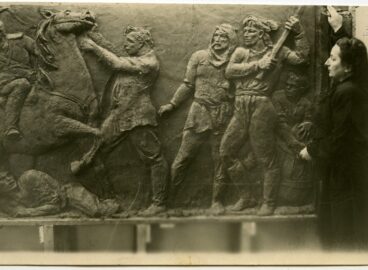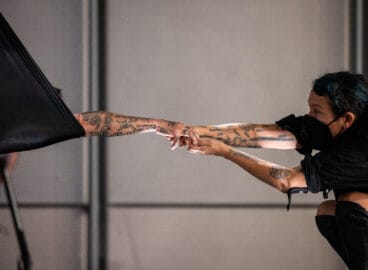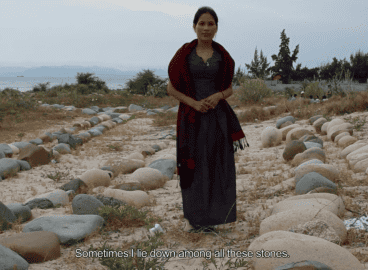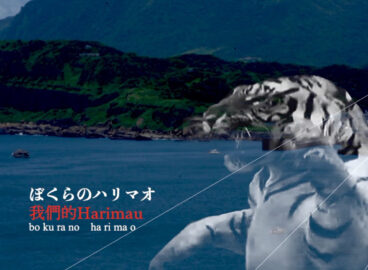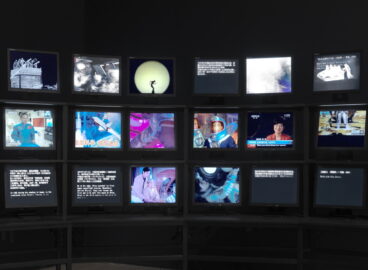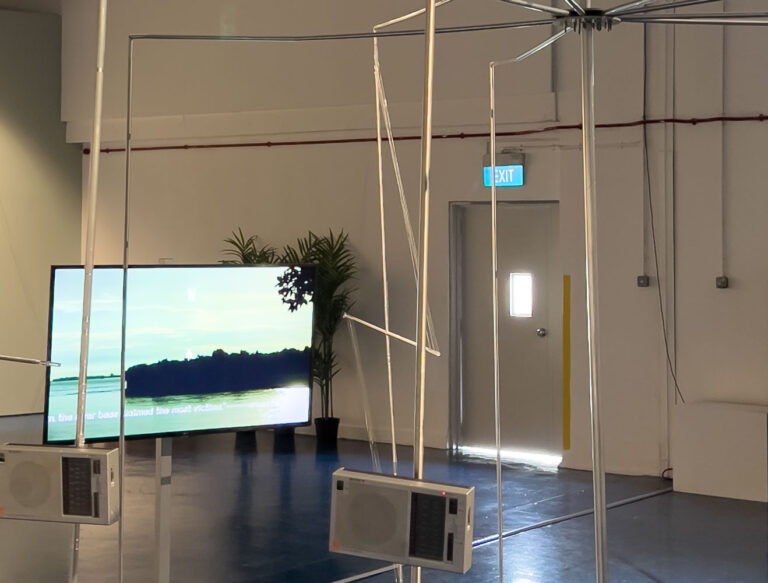
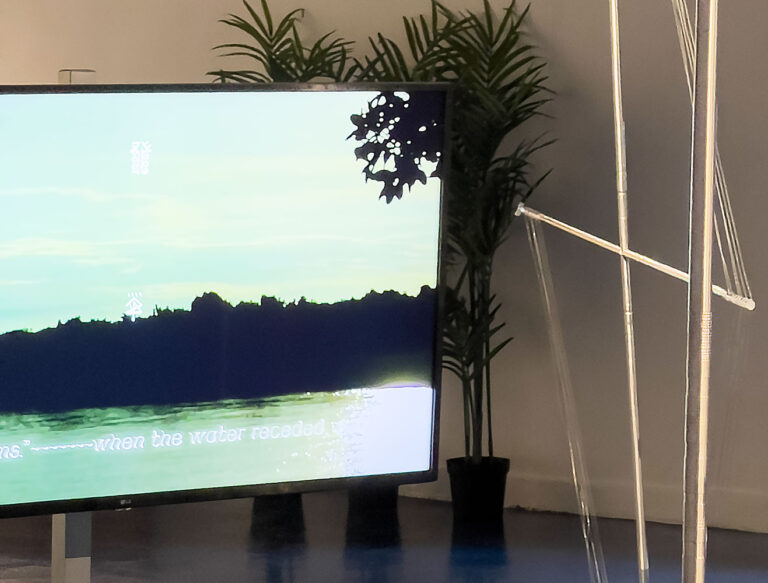
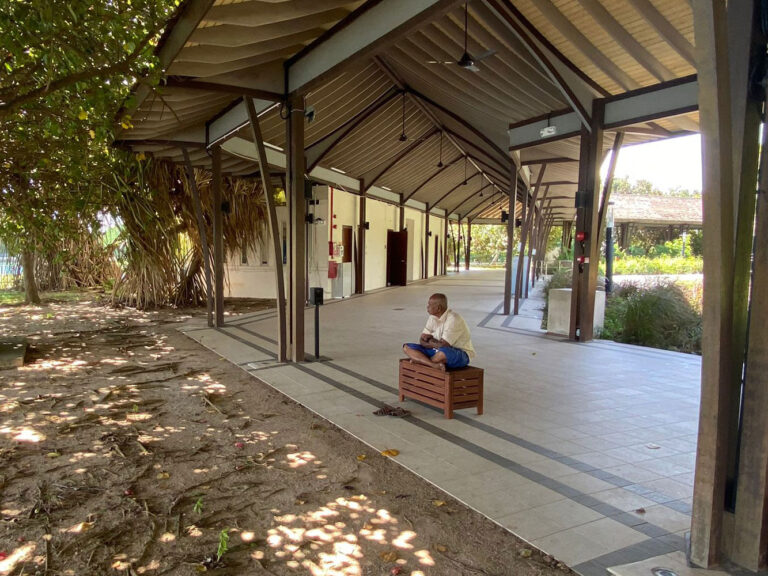

5.0: The Fifth Position
air cut into song was first installed in four parts at the seventh Singapore Biennale at the invitation of Nida Ghouse, one of the show’s four co-artistic directors. The artwork is part of an ongoing project that is less a comprehensive collection than a compilation of “gaps.” This fifth entry, composed of five videos and an accompanying essay, is an after-the-fact addition, a postscript or “second cut.” The “fifth” occupies a privileged position in music theory with a particular historical origin,1Daniel Heller-Roazen, The Fifth Hammer: Pythagoras the Disharmony of the World (New York: Zone Books, 2011). serving as a reminder as something in nature that continues to bring about disharmony. This is one proposition of this piece: to hold onto the incompleteness and disjuncture that gave rise to the project and the practices that continue to inspire it, that is, to let out some of the air in all its unfinishedness.
This ongoing work aims to think of matter, in this case, of air as a substance with material considerations, and its metamorphosis into the cultural medium of song, in its affective sensation. air cut into song questions the oscillation between these modes, focusing on the gap between matter and medium and the possibilities that such a cutout generates. The result of a large collaboration among sixteen artists, the tone and voice of the work is choral. Thus, the first-person “I” in this entry is, at times, a substitute for the compound “we,” acknowledging the contributions of the many named and unnamed individuals with whom the artwork was conceived, inspired, and generated. And yet, at the same time, I do not wish to speak on their behalf. The first four parts were split according to material composition and operational speed. These autonomous fragments were distributed across two physical sites: the fifth floor of the main exhibition space in Singapore Art Museum (SAM), which is housed within Tanjong Pagar Distripark, a shipping-container port, and St. John’s Island, a temporary public exhibition site located south of the mainland. These artistic components utilized the visual sightlines and cellular network between the two locations.
Within the institutional interior of SAM, an arrangement of six directional wire antennae in a radial pattern made up air cut into song 01: A Broken Sky (2022), a sculpture and operational live-listening device that I built together with artist and design engineer Flora Weil. It worked in real time to tune into radio channels in Singapore and was simultaneously engineered to be sensitive to the discharge of lightning activity from several hundred miles away.2The first such radio was used in North America during the 1930s to transmit information about dangerous weather conditions to ships at sea. In reverse engineering and modifying the radio receiver designed by Russian physicist and electrical engineer Aleksandr Popov in 1895, and building it by hand, Flora and I attempted a return to this double functioning between telecommunication and scientific capture. For more on Popov’s device and history, see W. H. Eccles, Wireless (London: T. Butterworth, 1933), 53–54; quoted in W. Rupert Maclaurin, Invention and Innovation in the Radio Industry (New York: Macmillan, 1949), 18. This work was based on the co-constitutive history of radio broadcasting and weather measurement, wherein one of the first radios was also used to detect lightning activity. Because of this design, the installation was susceptible to the electromagnetic charge of the exhibition space (literally the electrical wiring inside the walls and the residual static) and would continuously broadcast a low-volume white noise that was specific to what could be called the “weather” of the museum.3This was an inquiry into the context of the white cube, in which the whitened gallery wall facilitates a visual process of a certain solution to clear visual clutter, questioning the place of the ear: How can one be attuned to the air of the museum? How does one listen to the song of its hum, the frequential signature of its audible register?
The second part, a video work titled air cut into song 02: The Wind Between Two Winds (2022), was a live video feed from a camera attached to a metal post on St. John’s Island and pointed toward SAM’s main exhibition space. The video work was viewed on a screen located within the structure of air cut into song 01: A Broken Sky. The video was overlaid in real time by a set of graphic weather glyphs designed by the Malaysian type and design collective Huruf and based upon Malay weather charts and Chinese characters associated with the climate.4The members of Huruf are Sueh Li, Low Hsin Yin, Tan Zi Hao, David Ho Ming Aun, Fam Kai-Cong, and Louie Lee Wei Yi. Lakisha “Don” Jayasinghe assisted with the technical setup of the camera’s mobile-Internet relay system and computer-processing system. Huruf’s glyphs, arranged on the screen by a computer processing the real-time video feed according to set of predefined rules for describing the weather, resulted in an autonomous “annotation” of the weather through visual symbols.
Huruf’s symbols were framed by a horizontally scrolling text in a font created by graphic designer Ejin Sha. The text was a transcription from air cut into song 03: The Nat. Radio Weather Channel (2022), a two-channel sound work made with audiographer and sound artist Sukanta Majumdar and installed a few meters from where the camera relay was located on St. John’s Island. The stereophonic track was composed of recorded readings by “international weather correspondents”: a group of artists and scholars invited to read and interpret weather reports from important historical moments.5For example, historian Aanchal Malholtra described the rain and floods that occurred on the day of the Partition of India in 1947; Sabeen Chaudry discussed intermittent reports from the eighteenth-century ship Cardigan as it sailed to the East Indies; and Farouk Yahya narrated the weathered state of nineteenth-century Malay manuscripts containing weather charts.The first group of weather reporters included Aanchal Malhotra, Jerry C. Zee, Sabeen Chaudhry, Farouk Yahya, and Esra Musbahi, and later broadcasts were planned by Sanabel Abdelrahman and Nidhi Mahajan.
The final piece of this four-part compilation, air cut into song 04: Rainy Days (instrumental) (2022), which was installed on St. John’s Island, was made up of six metal panels into which ancient Arabic names and a diagram of winds and rains had been engraved. These panels were hung directly in front of the audio work and shielded seated listeners from the elements against the otherwise exposed oceanfront.
The experience of this artwork was intended to be piecemeal: you couldn’t read the transcript in the video and hear its audio component at the same time; you couldn’t simultaneously see the lightning in the sky and listen to its radiophonic crackle in the exhibition space. This bifurcation of the senses of sight and sound was necessary for the work to inhabit the space between matter and medium. This disharmony and conceptual challenge lend themselves to this fifth entry.
5.1: Heavy Air
As part of air cut into song 03: The Nat. Radio Weather Channel, anthropologist Jerry Zee described a hybrid matter that is both geological and gaseous, naming it “wind-sand.” Zee narrated this formation via the example of a dust storm that was blown by a Siberian jet stream from the desert of northern China, which borders Inner Mongolia, to Jeju Island off the Korea Strait in May 2001. In his weather report on this land-sky situation, Zee posed this question to listeners: “If the dust storm indicates the capacity of land to phase into an aerosol, as a Chinese desert in the sky, what could the term ‘weather’ mean? If not the passive meteorological background against which the dramas of state and society are lived; if not the realm of the atmosphere, to the exclusion of the earth that now fills it—makes it heavy with land, delivers [it] onto the plate glass windows of skyscrapers? Or enters it into lungs with the un-refusal of breath?”6A recording of Zee reporting on this meteorological event was broadcast as part of air cut into song 03: Nat. Radio Weather Channel.
This meteorological incident impresses a certain literalness: a delegation from Mainland China had visited South Korea that same month to resume and repair diplomatic relations between the two countries. Their arrival was coincidentally announced at the same time the very particles of the land they represented were arriving. The agenda for the 2001 mission was to ensure smoother trade and shipping along the East China Sea to the South China Sea between the two economic giants, and this weather event was an unexpected transmission broadcasting material proof of geographic interdependence between nation-states and, inevitability, the political reality of their correspondence.
The “wind-sand” determined the weather, land became contingent, and diplomacy was coupled with the downwind of atmospheric phenomena. The dust storm entered the South Korean airspace without consent, was breathed in by its population, and then entered their lungs without possibility of refusal. The ramifications in this combination of ineffective meteorological policy and the inescapable earthbound phenomena that produced the dust storm could be heard for some time after; indeed, an audible trace of this weather event was evident in the hoarse tonality of those who experienced and then spoke about it. The weather became biologic to a different degree, as laryngeal injury and involuntary vocal alteration.
In medical terms, subjection to this heavy air modified the faculty of the voice, with the particulate matter so fine that it spanned transnational distances, meaning it also penetrated the deepest parts of the lungs, causing inflammation and irritation of the vocal cords. This led to the acute states of epiglottitis, dysphonia, or general respiratory distress. Simply, with varying degrees, it changed how one spoke, the tenor of their exhale and wheeze, and their capacity to take in air.7This phenomenon has been the subject of numerous studies that have faced logistical challenges to analysis due to the volume and scale of a dust storm’s pervasiveness. See, for example, Young-Hoon Joo, Seong-Soo Lee, Kyung-do Han, and Kyung-Ho Park, “Association between Chronic Laryngitis and Particulate Matter Based on the Korea National Health and Nutrition Examination Survey 2008–2012,” PloS One 10, no. 7 (July 15, 2015), https://doi.org/10.1371/journal.pone.0133180.
In Jerry Zee’s earlier narration of the 2001 dust storm, he cites interviews undertaken as part of his long-term ethnographic project: “At daybreak, it was witnessed as an anti-optical event, as ground-level observers described seeing the dust by what they could not see. The density of the dust cloud, and its intensity disappeared buildings and eclipsed the morning sun.”8Jerry C. Zee, Continent in Dust: Experiments in a Chinese Weather System (Oakland: University of California Press, 2021). While Zee charts the geologies’ new regimes of visibility, I use this example to highlight the movement from the environment to vocal quality. As a mediatic shift from the geological to the sonic, it demonstrated the cut that was importantly not an aesthetic practice, but rather a harmful reality that not only came with grave consequences and also had historical precedence.
5.2: Phonotrauma
The 2001 diplomatic mission sought to facilitate oceanic trade across the Pacific to the Indian Ocean. A hinge in this Asian market was the oceanic conduit of Singapore and the container port of Tanjong Pagar, which is the place on view in the video works accompanying this piece (and where SAM is located). The air is an occlusion in the frame, filling the space between the camera lens and the view, a composite of floating matter and the compound of gas carrying it, visually collaged in the aperture of shipping containers, choreographic cranes, and waterborne vessels. It is the “in-between” space of this air that I want to focus on, to measure, and to be attuned to.
At noon on October 23, 2022, a westerly prevailing wind that had its origin in the Korean peninsula picked up speed along the Indian Ocean monsoon currents. This current of air then passed in front of the camera that is part of the artwork on St. John’s Island and found its final destination and dispersion in the Sahara beyond the East African coastline.9The wind direction was accessed by the author from Meteorological Service Singapore on the opening day of the seventh edition of the Singapore Biennale. This transcontinental transfer of matter became a conceptual bridge that allowed me to connect two culturally disparate traditions in South Korea and Algeria, respectively: the p’ansori ritual and the Aissawiyya Sufi’s remembrance practices.
In both rituals, the voice is transformed by the air that it uses to sing, demonstrating a shared understanding of the multiple provisions of the mechanics of breathing, of the pressure caused by the push of gas against the soft tissue of the body’s interior. This process involves a visceral “opening up,” a type of bodily augmentation through an intentional “phonotrauma.”10I am trying to redefine this term, and I am grateful to Professor Beth Simmel for the numerous conversations on this topic and for the additional reference from poet Eunsun Whang. See, by way of comparison, Nicolas Harkness, Songs of Seoul: An Ethnography of Voice and Voicing in Christian South Korea (Berkeley and Los Angeles: University of California Press, 2014); and Heather Willoughby, “The Sound of Han: P’ansori, Timbre and a Korean Ethos of Pain and Suffering,” Yearbook for Traditional Music 32 (2000): 17–30. The Saharan example stems from personal fieldwork in Libya, Tunisia, and Algeria and from numerous conversations with long-term collaborators Adam Anabosi, Alma Chaouachi, Sara Bouzgarrou, Thania Petersen, Sukanta Majumdar, and Sumayya Vally. These practices were concerned with the oscillation between air and song in a fundamental way, as a form of gaseous labor. For singers in either tradition, air was a way to literally tune their bodily organ as an instrument, facilitating the auto-mutilation necessary to achieve the shape required to make the correct sound.
In their preparatory breath work, the singer contorts and contracts the buccal and intrinsic laryngeal muscles so that the air agitates, literally aggravates and harasses, the soft tissue of the vocal fold within the throat. The aim is to transform the shape and elasticity of the voice and to use air to produce different sounds. The method of “breathing” to achieve this alteration differs: whereas p’ansori typically pushes the individual to sing at ever greater levels of loudness, to the point that “a singer will get blisters and she will bleed, but if she keeps practicing, at some point she will finally be able to sing.”11Harkness, Songs of Seoul, 98. In the Aissawiyya practice, the name of god (Allah) is broken down into three parts (Al – La – Hu) in order to regulate breathing, putting increased glottic pressure on the end of the exhaled third syllable (and thus the throat). This is repeated until the voice becomes so strained, it blends the distinction between the three segments of the word (Allah) into one.12This was observed in the author’s own interaction with different Aissawiyya groups in Algeria but is not unique among them. For Sufi devotees, a third component—how oxygen in the act of singing is regulated—is integral to their entering a trancelike state in correspondence with the melody and its spiritual meaning.
In this shared aspiration to let out air differently, a gap opens to an understanding that the conditions for song were materially differential. I do not mean to collapse the significance of the Korean and Saharan specificities; I take them together as they share a tactic of using air as a medium—to transfer a vibratory and auditory range of tone (in both traditions, singers sing without prosthetic accompaniment) and as matter—that physically modifies the structure of the sound-making faculty. They highlight how air as a substance has a long precedence in artmaking, and how the gap becomes a site of modulation and possibility.
5.3: Fishing for Dots
What empowered both p’ansori and Sufi practices was the ideal of a certain kind of song-making that considered the voice as a physical site made malleable by its surroundings. The tongue, lips, vocal cords, and cheeks move, contract, relax, and gesture to produce sound—all individual components of a broader atmospheric network that, in their orchestration, could achieve the “correct” performance. P’ansori performers traditionally practice in nature, and against nature—for example, being able to be “heard over the sound of waterfall” was a prerequisite for professional recognition and fueled an imaginary in which the outside world marks and is marked by the voice.13Joon Hee Shim, ed., Pansori: Commemorating Designation as a Masterpiece of Oral Tradition and Intangible Heritage of Humanity by UNESCO in 2003, trans. Hwang Hee Sook (Seoul: National Center for Korean Traditional Performing Arts, 2004), 54. To cry at the elements as an expression of lament is what I am calling a “phonotraumatic” act in how it embedded a sound signature as a scar on the interior of the singer’s throat that would then be carried onto the stage and into social settings.14P’ansori singers leverage this quality, in which the voice’s performance is distinct from the words being made and so, for example, they would simultaneously indicate the speed of the character’s footsteps through short staccato notes and recite the script of the story in parallel. See Tara McAllister-Viel, “Transmitting Voice Pedagogy: Interweaving Korean P’ansori and Contemporary Modes of Anglo-American Voice Training,” chap. 9 in Theatrical Speech Acts: Performing Language; Politics, Translations Embodiments, ed. Erika Fischer-Lichte, Torsten Jost, and Saskya Iris Jain (London: Routledge, 2020).
The capacity for auditory distinction, for how the air hits the eardrum, was a necessary aspect for realizing the vocal alteration by listening for the correct sound. There was a precision in the practice that required calibration, as it was taught within the local context of a cultural idiom (what would give rise to a regional “accent”) but was subsequently subverted by the very environment that surrounds it as these two examples highlight.
The training that comes with language and vocal qualities relies on an imitation of sounds and enunciation. I grew up speaking a northwestern Libyan dialect of Arabic, a mother tongue that was made to give up space for an Estuary English. Reading in Arabic obviously looks and sounds different than reading in English, and the logic of the reading differs more radically in the way each conceives of the speaker and her presence within the environment. The two contain radically opposite sensibilities regarding the mechanism to instruct how one was to make sounds from what they see.
Reading is a bodily act and, in Arabic, the phonetic process is aided by minute morphological differences between letterforms that make unique demands on the eye and how it scans the sentence. It is beyond the current exploration to highlight the relation of the reader to her environment (something I explored in an earlier artwork),15Prior to the seventh century, Arabic was written without dots in a script called rasm, which was the subject of an artistic research study I undertook in an earlier collaboration with Enass Khansa. See Moad Musbahi, “Semantic Condensation and Other Techno-Acoustic Devices,” Infrasonica (digital platform), Independent Pages / Wave #4 (April 2021), https://infrasonica.org/en/wave4/semanticcondensation. but to give a pertinent example, there are five letters distinguished only by the different placement of dots: baبي , ta تي , tha ثي , noon ني , yaa16I added a ي to each letter to be able to evidence this morphology. يي . Though the dot is the most minimal mark on a page, it is a significant arbiter of meaning while, at the same time, it exhibits an asymmetrical epigraphic economy that easily eludes the net of comprehensive capture, it was easy to miss. The weathering of older manuscripts meant reading these old Arabic texts was literally an exercise in fishing for dots.
Drawn and named differently, there were two dots that went for a lexical swim in a rectangular map named after its commissioner, the last ruler of the Abbasid empire caliph al-Ma’mūn of the ninth century.17A latter reproduction version is located at the Bodleian Library as part of the treatise Kitāb Gharāʾib al-funūn wa-mulaḥ al-ʿuyūn, which loosely translates as “The Book of Curiosities of the Sciences and Marvels for the Eyes.”
Al-Ma’mūn’s cartographic mistake transformed the ancient Arabic name for the kingdom of Java, as it appeared on the map, into a label on the page to designate the people as those who live there as “below the wind.” This scribal error altered the positions of the dot above the middle letter of the first word and under the last letter of the second word, in effect, changing (تخت الزبج) to (تحت الريح). The slip was slight, but in this new meaning and climatic determination, a people became defined by the atmosphere blowing above them, and so reading the weather took on a different valence; translated into Malay as “bawah angin,” it was borne into the present as a phrase still in use though denoting a more charged cultural meaning.18This typo hypothesis, introduced in Michael Francis Laffan, Islamic Nationhood and Colonial Indonesia: The Umma Below the Winds (London: Routledge, 2003), 59, is part of a larger and more complex debate.
The correspondence between Western Asia and Eastern Africa and the islands of Southeast Asia continued from this typo, propelled by Indian Ocean trade, such that in contemporary Malaysia, both Arabic and Latin alphabets are used in official and popular contexts. The introduction of the Arabic form into the Malay writing system (as well as those of Acehnese and Maguindanaon, among others) necessitated the addition of six new characters, and the script was given the name “Jawi,” which is also the Arabic word for “weather.” In this formulation, reading Malay in Arabic was, in a literal sense, reading the weather.19This realization came to me in a conversation. In the Libyan dialect of Arabic, “What is your weather” (“What is your jaw[i]”) is how one asks how another is doing. A typical response would be, “My weather is great.” Thus the popular usage of the word “jawi” was maintained.
5.4: The Approximate Tone
In describing the “weather” of the Malay writing system, the history of Latin is also riddled with many transformations, a textual lineage concerned with the production of meaning through spacing. For example, there were no gaps between words in written Latin and thus no differentiation between the beginning and end of a word; in other words, “it used to be written like this” would have appeared as “itusedtobewrittenlikethis.”20William S.-Y. Wang, “Language Structure and Optimal Orthography,” in Perceptions of Print: Reading Research in Experimental Psychology, ed. Ovid J. L. Tzeng and Harry Singer, Psychology Library Editions: Perception (London: Routledge, 1981), 229–31 This discrepancy is important in understanding how the same sounds can be produced by different visual practices.
I am not writing a history of orthography, of how the history of writing impacted that of speaking, but rather exploring how a textual lineage becomes important in terms of thinking about the artwork in the gap—a form of artmaking that moves between the abstract realm of linguistic expression to the concrete spacing of its material, graphic forms, and sonic performance.
What was at stake in the spacing of words in Latin was the practice of reading aloud and of reading silently, the latter being a rare occurrence until the thirteenth century in the Middle Ages of Europe.21Jyotsna Vaid, “Script Directionality Affects Nonlinguistic Performance: Evidence from Hindi and Urdu,in Scripts and Literacy: Reading and Learning to Read Alphabets, Syllabaries and Characters, ed. Insup Taylor and David R. Olson, Neuropsychology and Cognition, vol. 7 (Dordrecht: Kluwer Academic Publishers, 1995), 295–310.” The spaces between words were introduced in the moment in which “silent reading” was “invented,” and yet they also assisted in reading in isolation. Prior to the introduction of the space, Latin had to be read with others, in an oration or congregation, to be decipherable. It demanded that a human, in a gathering and specific environment, serve as a sonic aid.
Intra-textual space, that is the space within the text, afforded the oral reader a ready ability to decode not only the text’s meaning but also its indications for pitch, intonation, and tempo. At first, spaces were placed across moments in a sentence that would enable the fluent rendition of a syllable to pitch, a process that was necessary, for example, in the performance of medieval chants. This wasn’t space between words, but rather gaps introduced according to when one needed to take a breath. In this system, some words were still pressed against other words, and spaces were sometimes introduced within the middle of autonomous words, between two syllables that were separately vocalized before and after an inhale and exhale.
These gaps were first introduced in the seventh century by Irish scribes copying Latin manuscripts. This process resulted in something called “aerated text” or, literally, the airing out of the text.22Paul Saenger, Space Between Words: The Origins of Silent Reading (Stanford: Stanford University Press, 1997). I interpret that this was understood to relate to both the visual spacing between words in a script, and to the air within the mouth that was performing or singing the script. Even highly “aerated” text still opposed the arbitrary autonomy of words, whereby the script continued to wobble between grammar, rhythm, and visual image on the page. The air of the text was the literal air within the mouth, and its aeration was both an abstract notional form and its physical performance.
As development of Latin’s syntax progressed, words gained their status as individual semantic units of account; the hyphen, which became known as the “line of union,” attempted to further re-suture this history of linguistic unmooring.23M. B. Parkes, Pause and Effect: An Introduction to the History of Punctuation in the West (Farnham, UK: Ashgate, 1992), 36. While it is a solid horizontal element that weaves letters back into a definitive space, its more uncertain cousin, the tilde, is used as the symbol for approximation. The ~ is placed before a term that is deemed not completely determined.24Florian Cajori, A History of Mathematical Notations, vol. 1, Notations in Elementary Mathematics (Chicago: Open Court Publishing Company, 1928), 312. Taken from the Latin titulus, “a mark of suspension” over the letter, it was originally employed to indicate the rise in vocal pitch, to indicate uncertainty through tone.25Charles Trice Martin, comp., The Record Interpreter: A Collection of Abbreviations, Latin Words and Names Used in English Historical Manuscripts and Records, 2nd ed. (London: Stevens and Sons, 1910), 5.
The aeration and hesitation of the text, from the spacing between words to the use of symbols of approximation, are two instances of what I am referring to as gap-making. They highlight an aesthetic practice that has developed across a vast geography, where even an empty word-space or a single dot can be a hinge that transforms a cultural or environmental system. Much like the p’ansori and Aissawiyya Sufi singing modes, these tactics enabled a way to imagine what lies in the spacing between medium and matter, air and song.
5.5: On Being Cut Out
The five videos that make up this piece are edited segments from the air cut into song 02: A Wind Between Two Winds live stream. They show the view of the Tanjong Pagar Distripark container port four miles away from St. John’s Island in different moments of the day. Huruf’s glyphs populate the video across the frame, as annotations of the already-visible elements of the environment, and at the bottom is a scrolling text composed of transcripts from the weather reports heard in air cut into song 03: The Nat. Radio Weather Channel. The text utilizes a font Ejin Sha made in response to the project. Based on the tilde, it indicates the weather report’s statistical improbability and indeterminacy—as if to be read in the spirit of a rising question. Watching the actual weather alongside the glyphs of the weather, and reading about past weather in the present weather (the work was originally in real time) was an experiment to try to disrupt acts of reading and viewing.26It was a practice inspired by artists who think about the visible and readable as an environmental and aesthetic exploration, such as Glenn Ligon, for example, in Untitled (I Remember the Very Day that I Became Colored) of 1990, which deals with the specific violence of a history of anti-Blackness, and how it was wrought into language and weather simultaneously.
This disruption was present in the set of examples I drew from; in the ambiguity of land, atmosphere, and politics, such as the case of Zee’s “wind-sand,” in the examples of phonotrauma in the p’ansori and Aissawiyya, and in the last two explorations of literacy as the degree-zero of art as a text that tests itself. Air cut into song gathered these moments to pry open and try to inhabit the space between the concrete and the conceptual. By building a multipart series, with numerous collaborations, cultural contexts, historical moments, and speeds of transmission, I was hoping to question and pressure the gap between medium and matter.
In this way, working with others as credited in such a piece, and in leveraging references that show mistranslations, typos, adverse weather effects, and the “bruising” of the voice, is to take a position on art-making, authorship, and inclusion that cannot be completely sustained. I reference the “I” and “we” compound from the beginning of the piece to denote the debit of many named and unnamed influences in this work, and yet it continues to cut out aspects that cannot be accounted for while also hopefully questioning the disharmony of conceptual distinctions and other possible modes of practice.
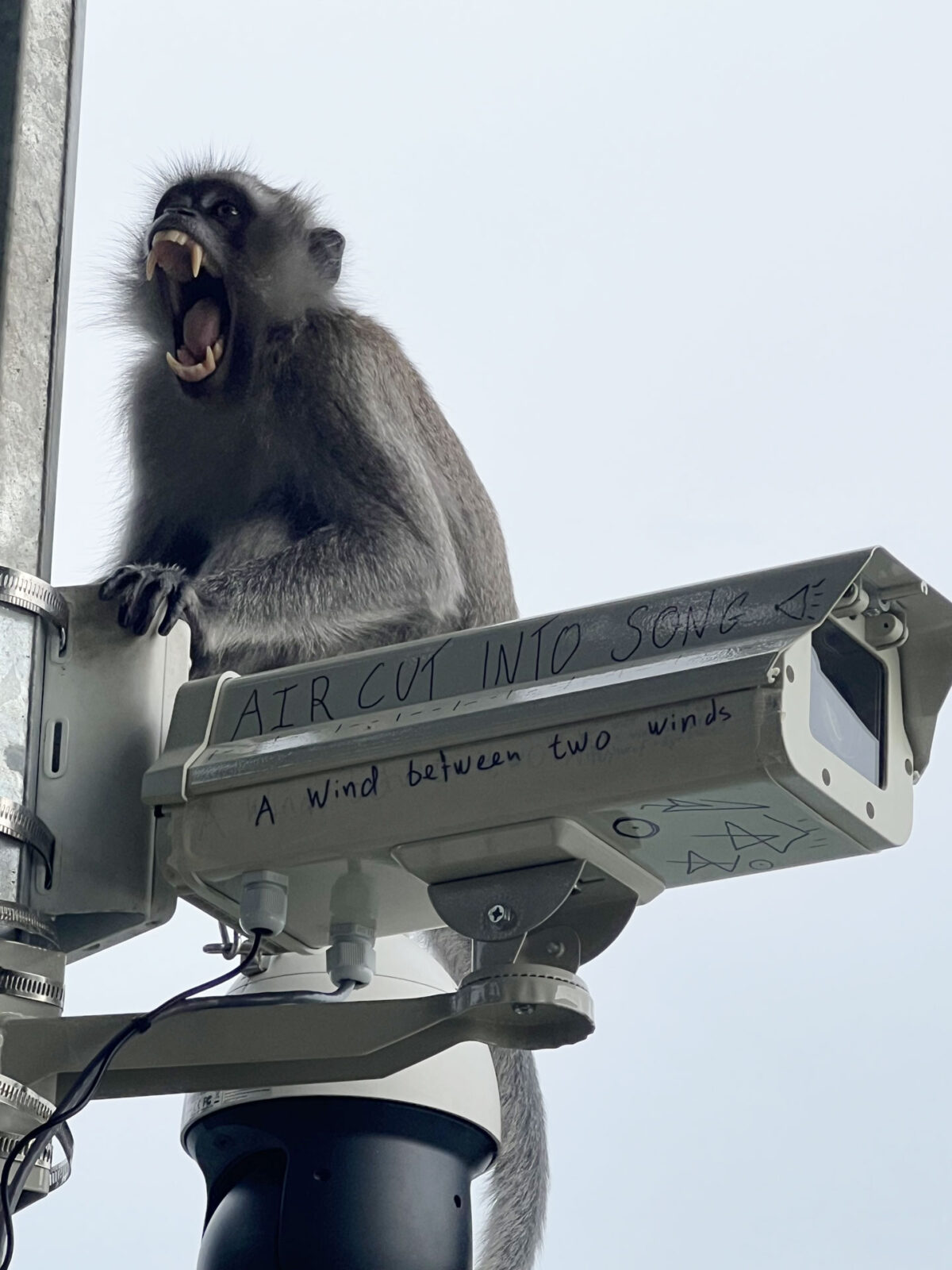
- 1Daniel Heller-Roazen, The Fifth Hammer: Pythagoras the Disharmony of the World (New York: Zone Books, 2011).
- 2The first such radio was used in North America during the 1930s to transmit information about dangerous weather conditions to ships at sea. In reverse engineering and modifying the radio receiver designed by Russian physicist and electrical engineer Aleksandr Popov in 1895, and building it by hand, Flora and I attempted a return to this double functioning between telecommunication and scientific capture. For more on Popov’s device and history, see W. H. Eccles, Wireless (London: T. Butterworth, 1933), 53–54; quoted in W. Rupert Maclaurin, Invention and Innovation in the Radio Industry (New York: Macmillan, 1949), 18.
- 3This was an inquiry into the context of the white cube, in which the whitened gallery wall facilitates a visual process of a certain solution to clear visual clutter, questioning the place of the ear: How can one be attuned to the air of the museum? How does one listen to the song of its hum, the frequential signature of its audible register?
- 4The members of Huruf are Sueh Li, Low Hsin Yin, Tan Zi Hao, David Ho Ming Aun, Fam Kai-Cong, and Louie Lee Wei Yi. Lakisha “Don” Jayasinghe assisted with the technical setup of the camera’s mobile-Internet relay system and computer-processing system.
- 5For example, historian Aanchal Malholtra described the rain and floods that occurred on the day of the Partition of India in 1947; Sabeen Chaudry discussed intermittent reports from the eighteenth-century ship Cardigan as it sailed to the East Indies; and Farouk Yahya narrated the weathered state of nineteenth-century Malay manuscripts containing weather charts.The first group of weather reporters included Aanchal Malhotra, Jerry C. Zee, Sabeen Chaudhry, Farouk Yahya, and Esra Musbahi, and later broadcasts were planned by Sanabel Abdelrahman and Nidhi Mahajan.
- 6A recording of Zee reporting on this meteorological event was broadcast as part of air cut into song 03: Nat. Radio Weather Channel.
- 7This phenomenon has been the subject of numerous studies that have faced logistical challenges to analysis due to the volume and scale of a dust storm’s pervasiveness. See, for example, Young-Hoon Joo, Seong-Soo Lee, Kyung-do Han, and Kyung-Ho Park, “Association between Chronic Laryngitis and Particulate Matter Based on the Korea National Health and Nutrition Examination Survey 2008–2012,” PloS One 10, no. 7 (July 15, 2015), https://doi.org/10.1371/journal.pone.0133180.
- 8Jerry C. Zee, Continent in Dust: Experiments in a Chinese Weather System (Oakland: University of California Press, 2021).
- 9The wind direction was accessed by the author from Meteorological Service Singapore on the opening day of the seventh edition of the Singapore Biennale.
- 10I am trying to redefine this term, and I am grateful to Professor Beth Simmel for the numerous conversations on this topic and for the additional reference from poet Eunsun Whang. See, by way of comparison, Nicolas Harkness, Songs of Seoul: An Ethnography of Voice and Voicing in Christian South Korea (Berkeley and Los Angeles: University of California Press, 2014); and Heather Willoughby, “The Sound of Han: P’ansori, Timbre and a Korean Ethos of Pain and Suffering,” Yearbook for Traditional Music 32 (2000): 17–30. The Saharan example stems from personal fieldwork in Libya, Tunisia, and Algeria and from numerous conversations with long-term collaborators Adam Anabosi, Alma Chaouachi, Sara Bouzgarrou, Thania Petersen, Sukanta Majumdar, and Sumayya Vally.
- 11Harkness, Songs of Seoul, 98.
- 12This was observed in the author’s own interaction with different Aissawiyya groups in Algeria but is not unique among them. For Sufi devotees, a third component—how oxygen in the act of singing is regulated—is integral to their entering a trancelike state in correspondence with the melody and its spiritual meaning.
- 13Joon Hee Shim, ed., Pansori: Commemorating Designation as a Masterpiece of Oral Tradition and Intangible Heritage of Humanity by UNESCO in 2003, trans. Hwang Hee Sook (Seoul: National Center for Korean Traditional Performing Arts, 2004), 54.
- 14P’ansori singers leverage this quality, in which the voice’s performance is distinct from the words being made and so, for example, they would simultaneously indicate the speed of the character’s footsteps through short staccato notes and recite the script of the story in parallel. See Tara McAllister-Viel, “Transmitting Voice Pedagogy: Interweaving Korean P’ansori and Contemporary Modes of Anglo-American Voice Training,” chap. 9 in Theatrical Speech Acts: Performing Language; Politics, Translations Embodiments, ed. Erika Fischer-Lichte, Torsten Jost, and Saskya Iris Jain (London: Routledge, 2020).
- 15Prior to the seventh century, Arabic was written without dots in a script called rasm, which was the subject of an artistic research study I undertook in an earlier collaboration with Enass Khansa. See Moad Musbahi, “Semantic Condensation and Other Techno-Acoustic Devices,” Infrasonica (digital platform), Independent Pages / Wave #4 (April 2021), https://infrasonica.org/en/wave4/semanticcondensation.
- 16I added a ي to each letter to be able to evidence this morphology
- 17A latter reproduction version is located at the Bodleian Library as part of the treatise Kitāb Gharāʾib al-funūn wa-mulaḥ al-ʿuyūn, which loosely translates as “The Book of Curiosities of the Sciences and Marvels for the Eyes.”
- 18This typo hypothesis, introduced in Michael Francis Laffan, Islamic Nationhood and Colonial Indonesia: The Umma Below the Winds (London: Routledge, 2003), 59, is part of a larger and more complex debate.
- 19This realization came to me in a conversation. In the Libyan dialect of Arabic, “What is your weather” (“What is your jaw[i]”) is how one asks how another is doing. A typical response would be, “My weather is great.” Thus the popular usage of the word “jawi” was maintained.
- 20William S.-Y. Wang, “Language Structure and Optimal Orthography,” in Perceptions of Print: Reading Research in Experimental Psychology, ed. Ovid J. L. Tzeng and Harry Singer, Psychology Library Editions: Perception (London: Routledge, 1981), 229–31
- 21Jyotsna Vaid, “Script Directionality Affects Nonlinguistic Performance: Evidence from Hindi and Urdu,in Scripts and Literacy: Reading and Learning to Read Alphabets, Syllabaries and Characters, ed. Insup Taylor and David R. Olson, Neuropsychology and Cognition, vol. 7 (Dordrecht: Kluwer Academic Publishers, 1995), 295–310.”
- 22Paul Saenger, Space Between Words: The Origins of Silent Reading (Stanford: Stanford University Press, 1997).
- 23M. B. Parkes, Pause and Effect: An Introduction to the History of Punctuation in the West (Farnham, UK: Ashgate, 1992), 36.
- 24Florian Cajori, A History of Mathematical Notations, vol. 1, Notations in Elementary Mathematics (Chicago: Open Court Publishing Company, 1928), 312.
- 25Charles Trice Martin, comp., The Record Interpreter: A Collection of Abbreviations, Latin Words and Names Used in English Historical Manuscripts and Records, 2nd ed. (London: Stevens and Sons, 1910), 5.
- 26It was a practice inspired by artists who think about the visible and readable as an environmental and aesthetic exploration, such as Glenn Ligon, for example, in Untitled (I Remember the Very Day that I Became Colored) of 1990, which deals with the specific violence of a history of anti-Blackness, and how it was wrought into language and weather simultaneously.
